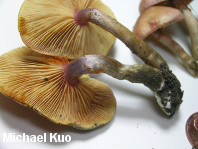| Major Groups > Gilled Mushrooms > Dark-Spored > Gymnopilus > Gymnopilus luteofolius |

|
Gymnopilus luteofolius [ Basidiomycota > Agaricales > Strophariaceae > Gymnopilus . . . ] by Michael Kuo This fantastic fungus showed up in my back yard some years ago, fruiting from treated lumber (!) set down around a landscaping area. Since then it has come back every year in October. The pale yellow gills of Gymnopilus luteofolius contrast nicely with the purplish red cap, and its partial veil becomes a flimsy ring or ring zone that catches the bright orange spores as they fall from the gills. Other distinguishing features for Gymnopilus luteofolius include its bitter taste, the purplish pink sliced flesh, and microscopic features—including relatively small, finely warted spores and abundant cheilocystidia. Several times my collections have demonstrated bluish green staining on the cap and stem and, although green stains were not included in the original description of the species (Peck, 1875), subsequent collectors (e.g. Stamets, 1996) have documented the phenomenon. However, in some years my back yard Gymnopilus does not stain blue. Go figure! Thanks to Linda Goodwin (who also found this species in her yard, on top of an "8 foot high pile of mixed pine and hardwood wood chips") for collecting, documenting, and preserving Gymnopilus luteofolius for study; her collection is deposited in The Herbarium of Michael Kuo. Description: Ecology: Saprobic on the deadwood of conifers (including commercial lumber and wood chips), and occasionally reported on the wood of hardwoods; usually growing in loose clusters or densely gregariously; summer and fall, or over winter in warm climates; apparently widely distributed in North America. The illustrated and described collections are from Illinois and North Carolina. Cap: 2–6 cm; convex, becoming broadly convex, broadly bell-shaped, or nearly flat; dry; densely to sparsely covered with small, innate scales, especially over the center; purplish red to pinkish brick red when young, fading to pinkish or yellowish (or somewhat mottled with these colors); eventually becoming brownish orange or tan; sometimes stained bluish green in places; the margin not lined. Gills: Attached to the stem by a notch; close; pale to medium yellow at first, becoming deeper yellow and developing rusty brown discolorations; eventually becoming rusty overall; short-gills frequent; when very young covered by a thin partial veil. Stem: 3–6 cm long; 3–6 mm thick; more or less equal, or sometimes with a slightly swollen base; purplish pink, becoming orangish to brownish; fibrillose; with a flimsy, ephemeral ring or with a ring zone near the apex; basal mycelium white. Flesh: Whitish; turning purplish pink in the cap when sliced, or not changing. Odor and Taste: Taste strongly bitter; odor not distinctive. Chemical Reactions: KOH olive to black on cap surface. Spore Print: Bright rusty orange. Microscopic Features: Spores 5.5–8.5 x 3.5–5 µm; more or less ellipsoid; verrucose; brownish orange in KOH; dextrinoid. Basidia 4-sterigmate. Pleurocystidia not found. Cheilocystidia abundant, scattered, or absent; 20–30 x 5–7.5 µm; clavate, subcapitate, or lageniform; smooth; thin-walled; hyaline to dark brownish orange in KOH. Pileipellis a cutis; elements 5–15 µm wide, smooth or encrusted, brownish orange in KOH, with clamp connections. REFERENCES: (Peck, 1875) Singer, 1951. (Hesler, 1969; Arora, 1986; Stamets, 1996; Barron, 1999; Desjardin, Wood & Stevens, 2015; Siegel & Schwarz, 2016.) Herb. Kuo 10251403, 10201701, 08312001. This website contains no information about the edibility or toxicity of mushrooms. |
© MushroomExpert.Com |
|
Cite this page as: Kuo, M. (2020, September). Gymnopilus luteofolius. Retrieved from the MushroomExpert.Com Web site: http://www.mushroomexpert.com/gymnopilus_luteofolius.html |












